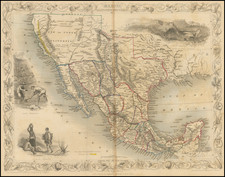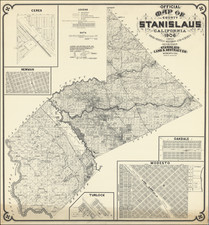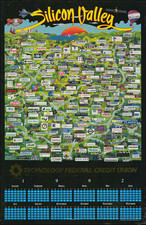Scarce contour map of the region around Oil City, prepared by the California State Mining Bureau.
Shows oil wells, topography, roads and public land survey sections.
The first time we have ever seen maps from this series in nearly 20 years.
Oil City, Fresno, County, California
Oil City is a section of land within the Coalinga area of Fresno County.
The first attempt to drill for oil was in 1867, but success was limited both due to the difficulty of transporting oil at the time, and the relative disinterest in petroleum prior to the era of motorized transport.
In 1890 the first oil boom began, once the Southern Pacific had extended its rail line into the town of Coalinga. Around the "Oil City" area of the Coalinga Field, directly north of the modern-day town of Coalinga, several large gushers attracted attention, gushers still being a relatively new occurrence in the oil industry. The "Blue Goose" well, drilled by the Home Oil Company, erupted in 1898, spewing over 1,000 barrels per day.
The huge and productive Temblor oil pools were discovered around 1900, and by 1910 the field was the most richly productive oil field in California, exceeding those in the Los Angeles Basin for the first time.
A dramatic oil gusher in Sept. 1909 at the "Silver Tip" well, producing 20,000 barrels a day, the biggest gusher in California until then. This was an event of such excitement that Los Angeles Stock Exchange closed down for a day so that its members could come by train to view it. This gusher would be dwarfed a year later by the colossal Lakeview Gusher, by which California's largest oil field, the Midway-Sunset in Kern County, was first known.
In the early years of the field, competition was fierce between different oil companies, with a particularly sharp conflict between a group of independent oil producers and Standard Oil, which operated as a gigantic trust until its breakup by the U.S. Supreme Court in 1911. According to an article published in the New York Times in 1905, Standard attempted to force its competitors out of business by artificially holding down the price of oil to as little as ten cents a barrel. The Coalinga independents responded by building a pipeline to San Francisco Bay, the construction of which was itself obstructed by continuous harassment from Standard, until the independents were finally successful by ruse: secretly building a real pipeline, while simultaneously seeming to work on a "dummy" pipeline in a more prominent location. During this time, the independent operators also accused the Southern Pacific Railroad of working in conjunction with Standard to put them out of business.









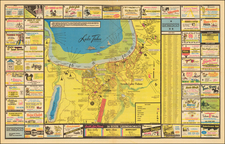
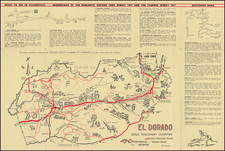
![[ Used by '49ers To Travel To California ] Map of Oregon and Upper California from the surveys of John Charles Fremont and others authorities drawn by Charles Preuss 1848](https://storage.googleapis.com/raremaps/img/small/100557.jpg)
